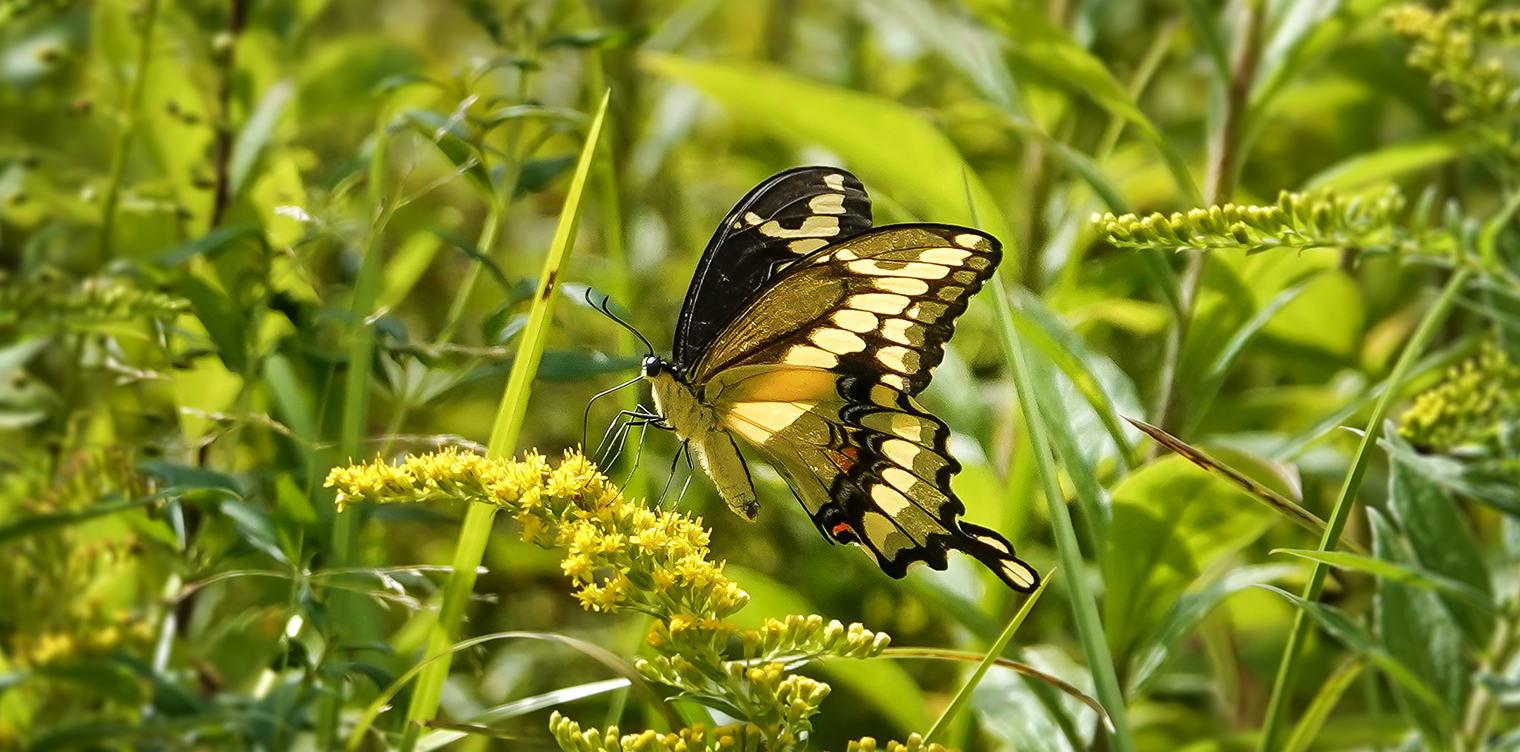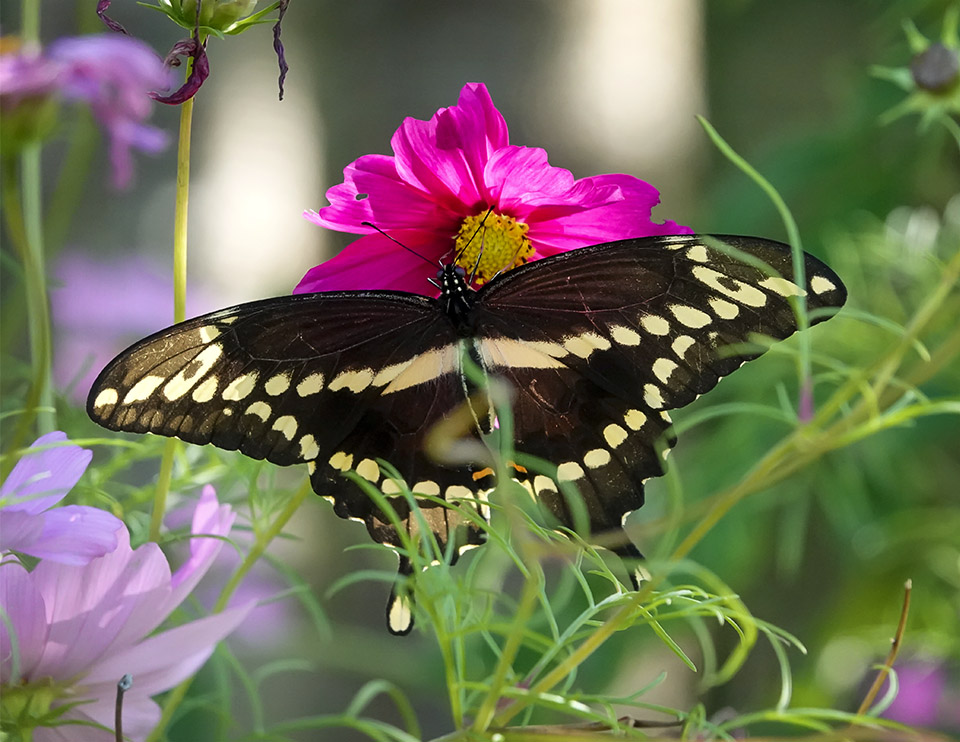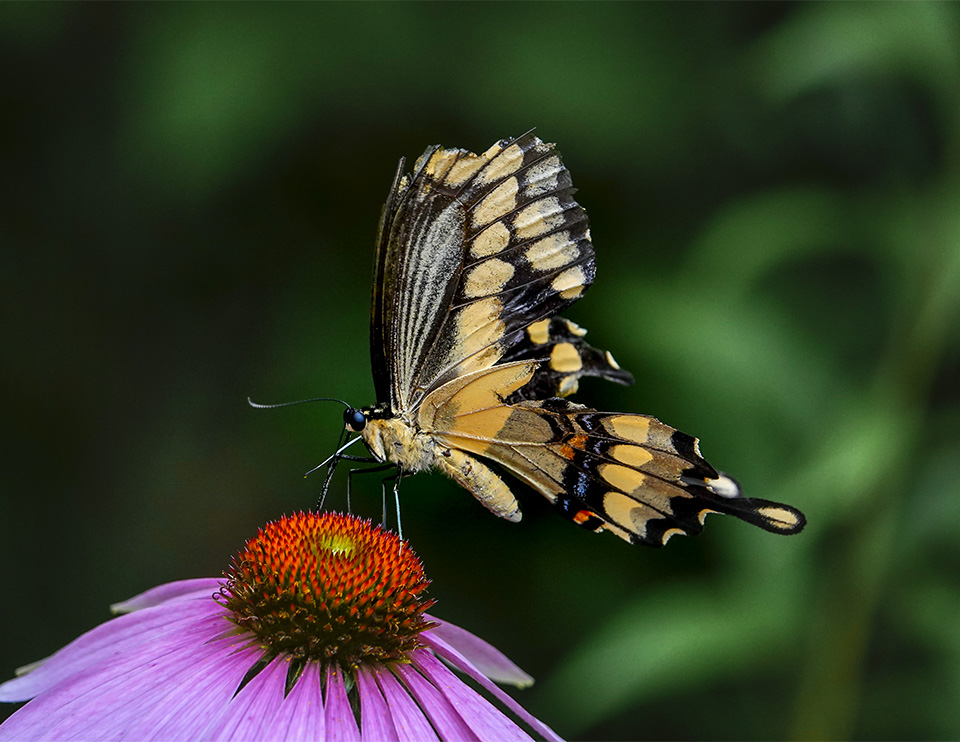Butterflies of the Adirondacks:
Giant Swallowtail (Papilio cresphontes)

The Giant Swallowtail (Papilio cresphontes) is a large butterfly that has occasionally been seen in the Adirondack Mountains of upstate New York in summer. It is a member of the family Papilionidae (Swallowtails), named for the tail-like projections on their hind wings, which resemble the tails of swallows.[1] The name "cresphontes" is said to be derived from Cresphonte, a character in Greek mythology.[2]
Giant Swallowtail: Identification

Adult Giant Swallowtails have long, dark spoon-shaped tails with a yellow center. Seen from above, these butterflies have very dark brown (almost black) wings with two bands of bright yellow spots which converge at the tip of the forewing. The bands form "Xs" near the apex of the forewings. The corner of the hindwing has an orange spot with a small blue eyebrow-shaped spot above it. [3]
From below, the dominant color of the Giant Swallowtail is light yellow, with black veins and borders. [4] [5] The underside hindwing has a blue median spot band. [6] There is a small, irregularly shaped reddish orange patch.
The body of the Giant Swallowtail is a creamy yellow. The abdomen has a broad black midline which tapers at the tip. The thorax has yellow lengthwise spots. [7]
The wingspan is four to 5½ inches. [8] Females are larger than males.
Giant Swallowtail: Life History
Female Giant Swallowtails lay single eggs on host leaves and twigs. The eggs are yellowish or light green and are laid singly on host leaves and twigs. [9] Caterpillars (sometimes referred to as "Orange Dogs") [10] [11] are brown or blackish with a pale cream or whitish saddle in the middle and a large cream patch on the tail. [12] Caterpillar hosts include trees and herbs of the citrus family. [13] [14]
Adult butterflies consume nectar from various plants including lantana, azalea, bouncing Bet, dame's rocket, goldenrod, Japanese honeysuckle, and swamp milkweed.[15] [16] Giant Swallowtail butterflies vibrate their wings while feeding at flowers, possibly for balance or to avoid tilting the blossom.[17]
Giant Swallowtail: Habitat and Range
The habitat of the Giant Swallowtail includes open woodlands and nearby fields, as well as cities, suburbs, towns, swamps, marshes, bogs, and citrus groves in the South. [18] [19] [20] The Giant Swallowtail is common in the southeastern parts of the US. [21] [22] [23] This butterfly may be found in eastern North America west to the Rocky Mountains.[24]
Most sources indicate that the normal range of this butterfly does not include northern New York and the Adirondack Mountains, [25] although they reportedly sometimes stray farther north than their usual range, occasionally forming colonies. [26] Giant Swallowtails have reportedly been becoming increasingly abundant in the central part of New York State and appear to be expanding along the northeastern boundary of their range. [27] During some recent summers, observers throughout New York State reported seeing more Giants than previous years.
Giant Swallowtail: Flight

The flight period for Giant Swallowtails in the Adirondack Mountains is not known. However, most Giant Swallowtail sightings from recent years cluster in mid- to late August.
- In 2012, there were sightings in the northern Adirondacks in late July, early August, and early September. In 2014, there were sightings in August. [28]
- A Giant Swallowtail was present in the Paul Smiths VIC Native Species Butterfly House in early August 2012. [29] Giant Swallowtails were also present in the Butterfly House in August 2013, August 2014, August 2018, August 2019. [30]
- Confirmed observations of Giant Swallowtaills reported on iNaturalist suggest an increased presence in the most recent years, with sightings reported in mid- and late August in 2016, 2017, 2018, and 2019.[31] [32] [33] [34]
References
- Susan Grimm Hanley. Interpretive Naturalist, Paul Smith's College Native Species Butterfly House. Species Logbooks.
- Butterflies and Moths of North America. Species Profiles. Sighting records: 8/4/2012; 8/4//2012; 8/12/2013; 8/19/2013; 8/19/2014; 8/11/2018; 8/24/2019; 8/26/2019. Retrieved 30 August 2019.
- iNaturalist. Adirondack Park Sightings 2016. Giant Swallowtail. Retrieved 24 August 2019.
- iNaturalist. Adirondack Park Sightings 2017. Giant Swallowtail. Retrieved 24 August 2019.
- iNaturalist. Adirondack Park Sightings 2018. Giant Swallowtail. Retrieved 24 August 2019.
- iNaturalist. Adirondack Park Sightings 2019. Giant Swallowtail. Retrieved 24 August 2019.
- Government of Canada. Canadian Biodiversity Information Facility. SpeciesBank. Retrieved 24 August 2019.
- Massachusetts Butterfly Club. Massachusetts Butterfly Species List. Retrieved 24 August 2019.
- Iowa State University. Department of Entomology. BugGuide. Retrieved 24 August 2019. Retrieved 24 August 2019.
- Susan D. Finkbeiner, Robert D. Reed, Robert Dirig, and John E. Losey. 2011. "The role of environmental factors in the northeastern range expansion of/Papilio cresphontes/ Cramer (Papilionidae)," Journal of the Lepidopterists' Society, 2011, 65(2):119-125.
- Yahoo Groups. NYSButterflies. Butterflies & Moths of New York.
- National Audubon Society. Field Guide to Butterflies (New York: Alfred A. Knopf, 1981), pp. 337-338.
- Jim P. Brock and Kenn Kaufman. Kaufman Field Guide to Butterflies of North America (Houghton Mifflin, 2003), pp.38-39.
- Paul A. Opler. A Field Guide to Eastern Butterflies (The Peterson Field Guide Series, Houghton Mifflin Company, 1992,1998), pp. 46-47, 50-51,54-55, 133-134.
- Jeffrey Glassberg. Butterflies of North America (Michael Friedman Publishing, 2002), pp. 58-59.
- James A. Scott. The Butterflies of North America. A Natural History and Field Guide (Stanford University Press, 1986), pp. 176-177.
- Donald and Lillian Stokes. Stokes Butterfly Book. The Complete Guide to Butterfly Gardening, Identification, and Behavior (Little, Brown and Company, 1991), pp. 44-49.
- Jeffrey Glassberg. Butterflies through Binoculars. The East. A Field Guide to the Butterflies of Eastern North America (Oxford University Press, 1999), pp. 46-47, Plate 2.
- Paul A. Opler and George O. Krizek. Butterflies East of the Great Plains: An Illustrated Natural History (The Johns Hopkins University Press, 1984), pp. 46-47, Plate 4.
- Rick Cech and Guy Tudor. Butterflies of the East Coast. An Observer's Guide (Princeton University Press, 2005), p. 68.
- David Carter. Butterflies and Moths (Dorling Kindersley, Inc., 1992), p. 50.
- David Badger. Butterflies (Voyageur Press, 2006), pp. 64-66.
- Jacqueline Y. Miller and Lee. D. Miller. The Butterfly Handbook (Barron's, 2004), p. 35.
